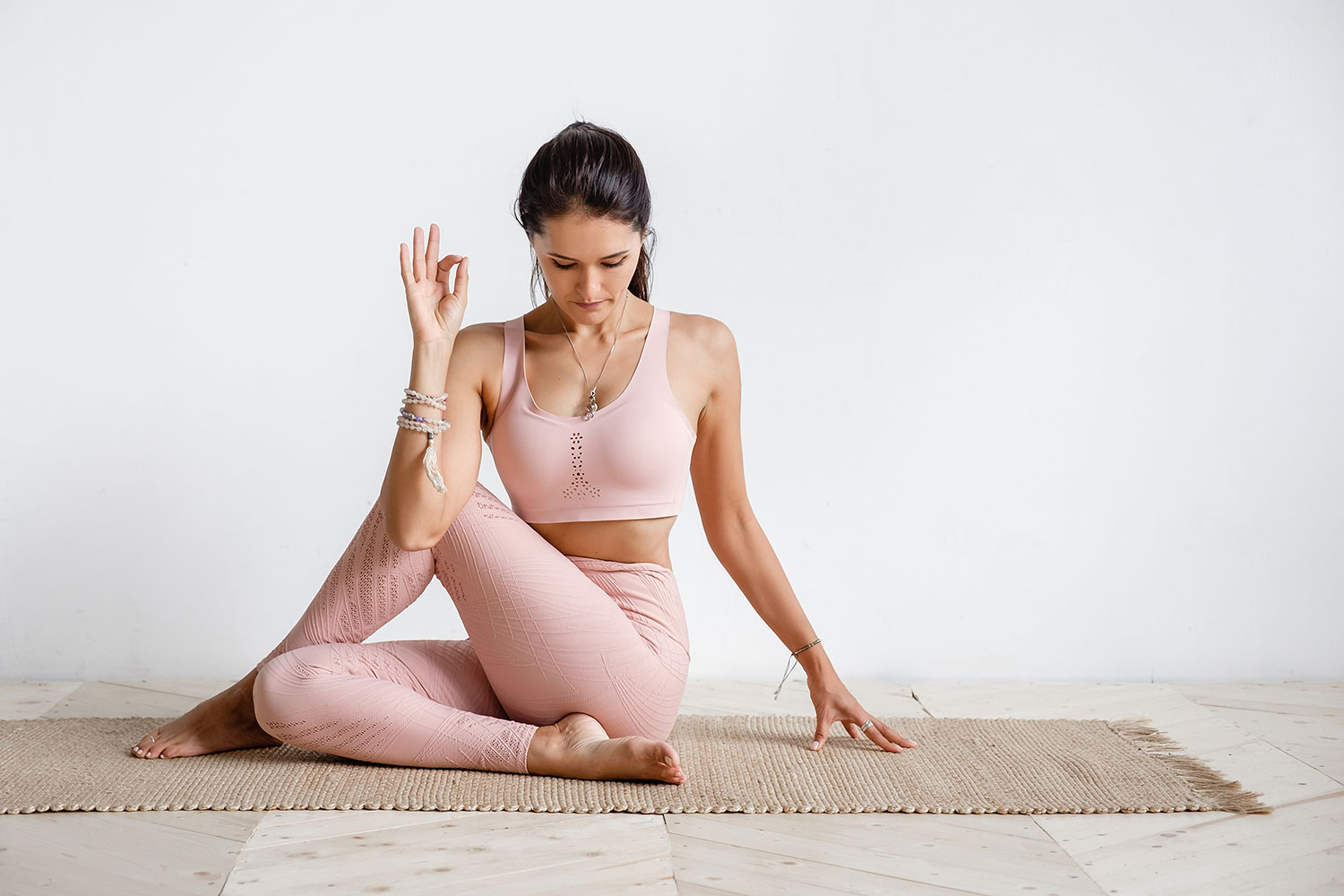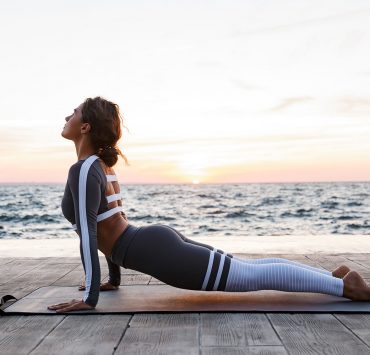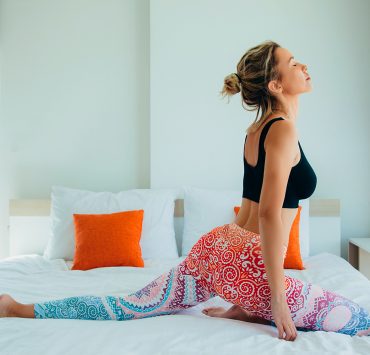
Yoga, meditation, and spirituality are at the top of the…
Modern lifestyle can put a lot of strain on your neck. From looking down at your phone to leaning forward to read your computer screen, your neck can take a beating. That pain can lead to further issues, from headaches to even injuries.
Thankfully, yoga can offer some assistance when it comes to strain on your neck—a study has shown that yoga can be a good treatment option for those with chronic neck pain. If you suffer from neck pain, the following yoga poses can help you let go of tension and bring some relief.
Parsva Balasana — Thread the Needle Pose

Thread the Needle, or Parsva Balasana, stretches the shoulders and upper back while gently stretching the spine and neck. The moderate spinal twist also assists in releasing tension.
Instructions:
Start in a table top position, with your palms and knees on the ground. Your wrists should be aligned directly under your shoulders, and your knees under your hips. Bring your head in a neutral position, with your gaze downwards.
On an exhale, lift the weight of your right hand and slide your right arm underneath your left arm, with your palm facing up. Your right shoulder should rest down on your mat, along with your right ear, with your gaze now facing left.
Your left arm can be bent or extended out in front of you, and your hips should remain raised. Bring awareness to your shoulders, neck, and lower back, and let go of any tension as you breathe through this pose. To release, bring your left hand back in line with your head if you extended it. Slowly push through your palm, return to table top, and repeat on the other side.
Matsyasana — Supported Fish Pose

Fish Pose, or Matsyasana, counteracts the hunching we find ourselves doing day to day, and can in turn relieve tension in the neck and shoulders. With a supported version, you can still reap the benefits, while taking on a more restorative position.
Instructions:
Find a prop to use, such as a block, pillow, or rolled up blanket. Lay down on your back, with your prop aligned horizontally across the bottom section of your shoulder blades. This will allow your chest to expand upward in this mild backbend.
Find an arm position that works well for you. You arms can remain at your sides, out to a “T” shape, or stretched out above your head. Once you find stillness, remain in this restorative posture for a minute or longer, allowing yourself to breathe deeply and let go of tension.
Marjaryasana — Cat/Cow Pose

Cat/Cow Pose, or Marjaryasana, is a great gentle warm-up pose that brings movement to the spine and back, which helps to release neck tension.
Instructions:
Begin on all fours, with palms and knees on the ground. Ensure your hands are stacked directly underneath your shoulders, and your knees underneath your hips.
On an exhale, move into Cat. Round your spine up towards the ceiling while tilting your tailbone down, and tuck your chin down towards your chest. While your head is tilting down, ensure you still leave space between your chin and your chest.
On your next inhale, move into cow pose. Raise your head and face forward, and tilt your tailbone up, allowing a curve in your back. Ensure you don’t tilt your head back too far or over arch your back, as it can result in strain.
Continue slowly alternating between Cat and Cow pose a handful of times, breath to movement. Give yourself time to fully feel the stretch as you move.
Garudasana — Seated Eagle Arms

Eagle Arms are great for stretching the space between your shoulder blades, as well as your neck and arms. The seated posture allows you to focus on the upper body stretch and target your neck, but you may choose to do full Eagle Pose, or Garudasana, for an all over body stretch.
Instructions:
Sit either on your knees or with your legs crossed, with your spine and neck lengthened. Extend your arms out in front of you at shoulder height, and then bend your right arm up and towards your face. Then, bend your left arm and wrap it underneath the right, wrapping so that you can work towards getting your palms to touch.
As you breathe through this posture, be mindful of making sure your shoulders do not creep up towards your ears. Work your arms away from your face so that you feel a deeper stretch in your shoulders and neck. Breathe here for about 30 seconds, and then repeat on the other side.
Arms Across Chest Pose

The Arms Across Chest Pose is a simple stretch that can deeply elongate the muscles in the back of your shoulders and your neck.
Instructions:
Sit on your mat, either on your knees or with your legs crossed, and sit up straight with your shoulders relaxed. Reach your right arm out, shoulder height, and bring it across your body towards your left side. Wrap your left arm underneath your right, so that it is underneath your right upper arm. You can clasp your opposite shoulder, or simply let your left hand hang. Hold for approximately 30 seconds, and then repeat on the opposite side.
Kantasanchalana — Ear to Shoulder Neck Rolls Pose

Simple stretches like Neck Rolls and Ear to Shoulder Pose also help to alleviate tension, and are easy to do anywhere as you go about your day.
Instructions:
For a Neck Roll, start seated in a comfortable position, on your knees or with your legs crossed. Sit up tall, with your spine and neck elongated. Bring your chin down towards your chest, and then slowly roll your head over to one side. Stay here for a moment, and then roll your head over to the opposite side. Rather than rolling your head backwards, continue making a “U” shape along your chest to avoid causing further tension.
After a few rounds back and forth, pause at the right shoulder. Place you left hand on your left shoulder, and then take your right arm over your head and gently place your palm on your left ear. Both hands should be applying light pressure, allowing you to deepen the stretch. After a few breaths, roll your head forward and repeat on the opposite side.
Ardha Matsyendrasana — Half Lord of the Fishes Pose

Half Lord of the Fishes Pose, or Ardha Matsyendrasana, lengthens, strengthens, and realigns the spine. The twisted element also helps to release tension.
Instructions:
Start in a seated position. Bend your right leg and bring your right foot alongside the outside of your left hip, with your leg fully on the floor. Bring your bent left knee over your right, with the sole of your foot fully on the ground by your upper right thigh.
Elongate your spine, and then twist your torso and shoulders over to the left, placing your left hand on the ground behind your glutes. Bring your right arm up, bend at the elbow, and then place it along the outside of your left thigh, with the lower half of your arm extended up. Bring your gaze over your left shoulder. Stay in this pose for about 30 seconds, and then release and repeat on the opposite side.
Gomukhasana — Cow Face Pose

Cow Face Pose, or Gomukhasana, provides a deep stretch along the shoulders, neck, arms, and chest, while also straightening the spine.
Instructions:
Start in a seated position. Bend your right arm behind your back, so that your hand is between your shoulder blades. Raise your left arm above your head, and bend your elbow so that your hand is behind your back.
Try to hook your hands together behind your back. If you are unable to do this, you can use a strap to make up that extra length. Hold the pose for about 30 seconds to a minute, being mindful that you are keeping your spine straight and breathing deeply. When you are done, release and repeat on the other side. Both sides can be different, so you may find that you only need the strap on one side.
Viparita Karani — Legs Up-the-Wall Pose

Legs Up-the-Wall Pose, or Viparita Karani, specifically stretches the back of the neck, as well as your front torso and legs, while also helping to alleviate any back aches.
Instructions:
From a seated position, bring your glutes up toward the wall. Lie onto your back, and swing your legs up against the wall, above your hips. Make any adjustments, such as bringing your hips closer to the wall. You may need to slightly bend your knees to make it more accessible.
Place your arms in a comfortable position, such as out in a “T” shape or stretched above your head. Remain in this restorative pose for about 30 seconds to a minute, with your eyes soft and breaths deep. Slowly and carefully release to one side into fetal pose to get out of the pose.
Forward Fold with Chest Expansion

A Forward Fold, or Uttanasana, uses your own body weight to release tension in the spine and neck, and the added Chest Expansion helps you get a deeper stretch in the shoulders and upper back.
Instructions:
Start standing with your feet hips-distance apart, and hinge forward at your hips. Bring your hands to the ground, and bend your knees as much as you need to. Release any tension in your neck, and stay in this pose for a few breaths to feel the stretch in your hamstrings and back.
To move into the chest expansion, remain folded and bring your arms behind your back, with your hands at your lower back. Clasp your hands together, and slowly bring them forward, towards your head. Try to keep your palms together, and don’t force your arms beyond your limits.
Ensure your head remains heavy and relaxed, and that your spine is elongated. Hold the position for about 30 seconds to a minute, and slowly roll up to get out of the pose, releasing your hands at the top.
Uttana Shishosana — Puppy Pose

Extended Puppy Pose, or Uttana Shishosana, is a restorative pose that lengthens the spine and shoulders, and also has a calming effect.
Instructions:
Begin in a table top pose, with your wrists under your shoulders and knees under your hips. Tuck your toes, and then start to walk your hands forward. Then, drive your glutes back and down, but keep them off your heels.
Rest your forehead on the ground, and keep your arms engaged, with your palms on the ground and elbows lifted.
Bring awareness to your neck and shoulders and release any tension, allowing them to fully relax. Continue to feel the stretch in your arms, and reach them out further if you’d like to go deeper. Hold for about a minute or longer, and slowly bring yourself back up to table top to get out of the pose.
Sasangasana — Rabbit Pose

Practicing Rabbit Pose, or Sasangasana, allows you to create space along the length of your spine, while also stretching your shoulders and neck.
Instructions:
Begin by sitting back on your heels. Reach back and grab your heels, with your thumbs on the outside of your feet.
On an exhale, roll down towards the ground and place the top of your head on the mat and towards your knees, so that your forehead is touching your knees.
While still holding onto your heels, begin to lift your hips and roll forward until your arms are fully straightened. Hold the position for about 30 seconds to a minute, and slowly bring your hips back down to your heels and roll back to release yourself from the pose.
Salamba Balanasana — Child’s Pose

Child’s Pose, or Balasana, is an excellent restorative pose that helps release tension from your neck while stretching and opening up your back area. It is also a great way to turn your focus inward and calm your mind.
Instructions:
Begin on your knees, sitting back onto your heels. Separate your knees from each other, but ensure your big toes remain touching.
On an exhale, bend forward from your hips and bring your torso forward, leading your forehead to the ground. Your torso should rest between your knees.
Extend your arms out in front of you, with your palms resting on the ground and arms remaining active and lifted. Ensure that you are releasing your tailbone towards your heels, and continue to lengthen your spine as you deeply breathe in this position.
Hold the position for a minute or longer, and slowly lead yourself back up to release.
Try out the poses listed above, and see how they affect your overall pain levels. Remember that consistency is key, so try to fit in a few stretches and poses as much as possible to bring some relief to your neck.
What's Your Reaction?
Yoga, meditation, and spirituality are at the top of the list for writer and former nutritionist Amanda Carter. This devoted practitioner enjoys writing about health and wellness just as much as she enjoys living it.














